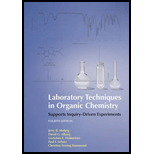
Interpretation:
The error that has been made by student in the setup should be determined.
Concept introduction:
Distillation is a liquid-gas separation technique for two or more liquids on the basis of their difference in boiling temperature or vapor pressure.Vapor pressure is pressure exerted by vapor phase of liquid produced due to an increase in the molecular kinetic energy of the liquid phase or due to the increase in temperature.
The temperature at which atmospheric pressure exerted on liquid equals to its vapor pressure is known to be its boiling point. Vapor pressure of the component decide boiling point of any mixture. Impurities in the mixture might result in an increase or decrease of observed boiling temperature.
The steps for distillation are as follows:
- In distillation, a round bottom flask is filled one-third or half full with the liquid compound to be distilled. If the flask is overfilled it might flow inside condenser attached to it.
- Then a distilling head is inserted into the round bottom flask and then a condenser is attached to the side joint of the distilling head from where the compound is collected in another smaller round bottom flask after distillation.
- A heat source is placed below the distillation flask.
- A thermometer is carefully inserted in the thermometer adaptor and is placed properly on the distillation head for measuring the boiling temperature of the compound being distilled.
Want to see the full answer?
Check out a sample textbook solution
Chapter 12 Solutions
Laboratory Techniques in Organic Chemistry
- What is the product of the reaction? F3C. CF3 OMe NaOH / H₂Oarrow_forwardWhat would you expect to be the major product obtained from the following reaction? Please explain what is happening here. Provide a detailed explanation and a drawing showing how the reaction occurs. The correct answer to this question is V.arrow_forwardPlease answer the question for the reactions, thank youarrow_forward
- What is the product of the following reaction? Please include a detailed explanation of what is happening in this question. Include a drawing showing how the reagent is reacting with the catalyst to produce the correct product. The correct answer is IV.arrow_forwardPlease complete the reactions, thank youarrow_forwardConsider the synthesis. What is compound Y? Please explain what is happening in this question. Provide a detailed explanation and a drawing to show how the compound Y creates the product. The correct answer is D.arrow_forward
- What would be the major product of the following reaction? Please include a detailed explanation of what is happening in this question. Include steps and a drawing to show this reaction proceeds and how the final product is formed. The correct answer is B. I put answer D and I don't really understand what is going on in the question.arrow_forwardWhat is the product of the following reaction? Please explain what is happening in this question. Provide a detailed explanation and a drawing showing how the reagent is reacting with the catalysts to product the correct product. The correct answer is B.arrow_forwardWhat is the missing intermediate 1 and the final product 2. Please include a detailed explanation explaining the steps of malonic ester synthesis. Please include drawings of the intermediate and how it occurs and how the final product is former.arrow_forward
 Chemistry: The Molecular ScienceChemistryISBN:9781285199047Author:John W. Moore, Conrad L. StanitskiPublisher:Cengage Learning
Chemistry: The Molecular ScienceChemistryISBN:9781285199047Author:John W. Moore, Conrad L. StanitskiPublisher:Cengage Learning
